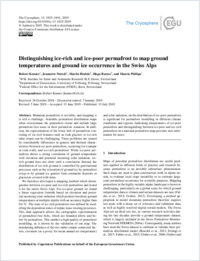Distinguishing ice-rich and ice-poor permafrost to map ground temperatures and ground ice occurrence in the Swiss Alps
- Kenner, Robert WSL Institute for Snow and Avalanche Research SLF, Davos, Switzerland
- Noetzli, Jeannette WSL Institute for Snow and Avalanche Research SLF, Davos, Switzerland
- Hoelzle, Martin Department of Geosciences, University of Fribourg, Switzerland
- Raetzo, Hugo Federal Office for the Environment (FOEN), Bern, Switzerland
- Phillips, Marcia WSL Institute for Snow and Avalanche Research SLF, Davos, Switzerland
-
15.07.2019
Published in:
- The Cryosphere. - 2019, vol. 13, no. 7, p. 1925–1941
English
Mountain permafrost is invisible, and mapping it is still a challenge. Available permafrost distribution maps often overestimate the permafrost extent and include large permafrost-free areas in their permafrost zonation. In addition, the representation of the lower belt of permafrost consisting of ice-rich features such as rock glaciers or ice-rich talus slopes can be challenging. These problems are caused by considerable differences in genesis and thermal characteristics between ice-poor permafrost, occurring for example in rock walls, and ice-rich permafrost. While ice- poor permafrost shows a strong correlation of ground temperature with elevation and potential incoming solar radiation, ice-rich ground does not show such a correlation. Instead, the distribution of ice-rich ground is controlled by gravitational processes such as the relocation of ground ice by permafrost creep or by ground ice genesis from avalanche deposits or glacierets covered with talus. We therefore developed a mapping method which distinguishes between ice-poor and ice-rich permafrost and tested it for the entire Swiss Alps. For ice-poor ground we found a linear regression formula based on elevation and potential incoming solar radiation which predicts borehole ground temperatures at multiple depths with an accuracy higher than 0.6 ∘C. The zone of ice-rich permafrost was defined by modelling the deposition zones of alpine mass wasting processes. This dual approach allows the cartographic representation of permafrost-free belts, which are bounded above and below by permafrost. This enables a high quality of permafrost modelling, as is shown by the validation of our map. The dominating influence of the two rather simple connected factors, elevation (as a proxy for mean annual air temperature) and solar radiation, on the distribution of ice-poor permafrost is significant for permafrost modelling in different climate conditions and regions. Indicating temperatures of ice- poor permafrost and distinguishing between ice-poor and ice-rich permafrost on a national permafrost map provides new information for users.
- Faculty
- Faculté des sciences et de médecine
- Department
- Département de Géosciences
- Language
-
- English
- Classification
- Hydrology
- License
-
License undefined
- Identifiers
-
- RERO DOC 326969
- DOI 10.5194/tc-13-1925-2019
- Persistent URL
- https://folia.unifr.ch/unifr/documents/308102
Statistics
Document views: 152
File downloads:
- pdf: 178
